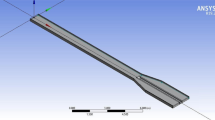Abstract
Various parameters such as bed and bank materials, shape and irregularity of the section, vegetation, river meanders, plan of the river path etc. affect the flow hydraulic resistance. In open channel hydraulics the effects of all these parameters are generally considered as the roughness coefficient. The Manning’s equation is one of the most practical equations to flow resistance analysis, in which the surface roughness is defined by Manning coefficient. Since many parameters are effective on the value of this coefficient, in this research study it was tried to define the roughness coefficient somehow that it be able to dynamically change with different river and hydraulic conditions. The collected data in Karun River (Iran) for two periods were used as the case study. It is shown that the accuracy of model predictions for water surface elevations were improved more than 13% in error estimation in comparison with the corresponding results obtained for a constant roughness coefficient. The roughness coefficient (n) for Karun River was also estimated using the empirical method proposed by Cowan for two different dry and wet periods. These values were then successfully compared with the average corresponding roughness coefficients calculated by the numerical model for those periods.
Similar content being viewed by others
References
Aldridge, B.N. and Garrett, J.M., Roughness Coefficients for Stream Channels in Arizona, U.S. Geological Survey Open-File Report, 1973, p. 87.
Anderson, B.G., On the impact of riparian vegetation on catchment scale flooding characteristics, PhD Thesis, University of Melbourne, 2005.
Arcement, G.J. and Schneider, V.R., Guide for selecting Manning’s roughness coefficients for natural channels and flood plain, U.S. Geological Survey Water-Supply Paper 2339, 1986.
Barnes, H.H., Jr., Roughness characteristics of natural channels, U.S. Geological Survey Water-Supply Paper 1849, Washington: US Government Printing Office, 1967, p. 213.
Benson, M.A. and Dalrymple, Tate, general field and office procedures for indirect discharge measurements, U.S. Geological Survey Techniques of Water-Resources Investigations, book 3, chap. Al, 1967, p. 30.
Chen, C.I., Flow resistance in broad shallow grassed channels, J. Hydraul. Div., ASCE, 1976, vol. 102, no. 3, pp. 307–322.
Chow, V.T., Open-Channel Hydraulics, McGraw-Hill Book Co., 1959, pp. 98–114.
Cowan, W.L., Estimating hydraulic roughness coefficients, Agric. Engin., 1956, vol. 37, no. 7, pp. 473–475.
Cunge, J.A., Holly, F.M., and Verwey, A., Practical Aspects of Computational River Hydraulics, London: Pitman Publishing Limited, 1980, p. 420.
Ding, Y., Jia, Y., and Wang, S. S. Y., Identification of Manning’s roughness coefficient in shallow water flow, J. Hydraul. Engin., ASCE, 2004, vol. 130, no. 6, pp. 501–510.
Fathi-Moghadam, M. and Kouwen, N., Nonrigid, nonsubmerged, vegetative roughness on floodplains, J. Hydraul. Engin., ASCE, 1997, vol. 123, no. 1, pp. 51–57.
Fathi-Moghadam, M., Kashefipour, M., Ebrahimi, N., and Emamgholizadeh, N., Physical and numerical modeling of submerged vegetation roughness in rivers and flood plains, J. Hydraul. Engin., ASCE, 2011, vol. 16, no.11, pp. 858–864.
Fisher, K.R., Handbook for assessment of hydraulic performance of environmental channels, Wallingford, Great Britain. HR Wallingford, 1996, Report SR 490, p. 346.
Joranova, A.A., Birkhead, A.L., James, C.S., and Kleynhans, C.J., Hydraulics for determination of the ecological reserve for rivers, WRC Report no. 1174, Pretoria, South Africa, 2004.
Kashefipour, S.M., Modeling flow, water quality and sediment transport processes in riverine basins, PhD Thesis, Cardiff: Cardiff University, 2002, p. 306.
Khatua, K.K., Patra, K.C., and Nayak, P., Meandering effect for evaluating of roughness coefficients in open channel flow, Dep. Civil. Eng. Conf. on Advanced in Fluid Mechanics, India, 2010.
Kouwen, N. and Fathi-Moghadam, M., Friction factors for coniferous trees along rivers, J. Hydraul. Engin., ASCE, 2000, vol. 126, no. 10, pp. 732–740.
Limerinos, J.T., Determination of the manning coefficient from measured bed roughness in natural channels, U.S. Geological Survey Water-Supply Paper 1898-B, Washington: US Government Printing Office, 1970, p. 47.
Author information
Authors and Affiliations
Corresponding author
Additional information
The article is published in the original.
Rights and permissions
About this article
Cite this article
Mohammadi, S., Kashefipour, S.M. Numerical modeling of flow in riverine basins using an improved dynamic roughness coefficient. Water Resour 41, 412–420 (2014). https://doi.org/10.1134/S0097807814040149
Received:
Published:
Issue Date:
DOI: https://doi.org/10.1134/S0097807814040149




